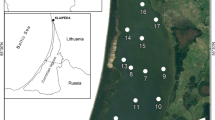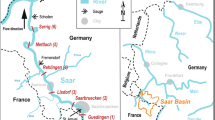Abstract
Ecological processes driving the oxygen budget were investigated in the downstream part of the Seine River and its estuary. Phytoplankton and bacterioplankton production were measured along longitudinal profiles (11 to 17 stations) in a range of low discharges from 300 m3 s−1 in 1993 and 1995 to 140 m3 s−1 in 1996. Values representative of the water column were based on investigations carried out during two tidal cycles. Net primary production was invariably greatest in the freshwater estuary, from Poses to Rouen (from 500 to 1,000 μg C l−1 d−1 between PK 202 and 240) and decreased sharply downstream (from 10 to 25 μg c l−1 d−1 between PK 250 and 310). This decrease was mainly due to the deterioration of the light conditions with the increase in depth and suspended matter concentrations. Heterotrophic activity was maximum in the reach where primary production declined. Judging by the production:respiration ratio (P:R), the system appeared clearly heterotrophic in the Seine River immediately downstream of the Paris region due to high allochthonous organic pollution by the incompletely treated Parisian effluents and in the part of the estuary characterized by intense degradation of autochthonous material. Because the effluents are not treated by a nitrification step, the oxygen consumption due to nitrification was much higher than expected from the P:R ratio. Oxidation of ammonium represented an oxygen consumption of between 1 and 14 g O2 m−2 d−1, almost equalling the sum of heterotrophic respirations that were barely balanced by photosynthesis. The reaeration flux at the water-atmosphere interface was deduced from the calculations and a reaeration coefficient was estimated.
Similar content being viewed by others
Literature Cited
Admiral, W. andY. J. H. Botermans. 1989. Comparison of nitrification rates in three branches of the lower river Rhine.Biogeochemistry 8:135–151.
Akopian, M. 1999. Cinétique et rôle du zooplancton dans les flux de matière particulaire: Du lac de Der-Chnatecoq (réservoir de la Marne) à l’estuaire de la Seine. Ph.D. Thesis, Université Paris, Paris.
Akopian, M., J. Garnier, P. Testard, andA. Ficht. 2001. Estimating the benthic population ofDreissena polymorpha and its impact in the lower Seine River, France.Estuaries 24:1003–1014.
Alpine, A. E. andJ. E. Cloern. 1992. Trophic interactions and direct physical effects control phytoplankton biomass and production in an estuary.Limnology and Oceanography 37:946–955.
Aminot, A., M. El-Sayed, andR. Kerouel. 1990. Fate of natural and anthropogenic dissolved organic carbon in the macrotidal Elorn estuary (France).Marine Chemistry 29:255–275.
Barillier, A. andJ. Garnier. 1993. Influence of temperature and substrate concentration on bacterial growth yield in Seine River water batch cultures.Applied and Environmental Microbiology 59:1678–1682.
Billen, G. andJ. Garnier. 1997. The Phison River plume: Coastal eutrophication in response to changes in land use and water management in the watershed.Aquatic Microbial Ecology 13:3–17.
Billen, G. andJ. Garnier. 1999. Nitrogen transfers through the Seine drainage network: A budget based on the application of the Riverstrahler model.Hydrobiologia 410:139–150.
Billen, G., J. Garnier, A. Ficht, andC. Cun. 2001. Modelling the response of water quality in the Seine River estuary to human activity in its watershed over the last 50 years.Estuaries 24:977–993.
Billen, G., J. Garnier, andP. Hanset. 1994. Modelling phytoplankton development in whole drainage networks: The RIVERSTRAHLER model applied to the Seine River system.Hydrobiologia 289:119–137.
Brion, N. 1997. Etude du processus de nitrification à l'échelle de grands réseaux hydrographiques anthropisés. Thèse Européenne, Dr. Sciences Agronomiques, Université Libre de Bruxelles, France.
Brion, N. andG. Billen. 1998. Une réévaluation de la méthode d’incorporation de14HCO3− pour mesurer la nitrification autotrophe et son application pour estimer des biomasses de bactéries nitrifiantes.Revue des Sciences de l’Eau 11:283–302.
Brion, N. andG. Billen. 2000. Wastewater as a source of nitrifying bacteria in river systems: The case of river Seine downstream from Paris.Water Research 34:3213–3221.
Brion, N., G. Billen, L. Guezennec, andA. Ficht. 2000. Distribution of nitrifying activity in the Seine River (France) and its estuary.Estuaries 23:669–682.
Caffrey, J. M., J. E. Cloern, andC. Grenz. 1998. Changes in production and respiration during a spring phytoplankton bloom in San Francisco Bay, California, USA: Implication for net ecosystem metabolisms.Marine Ecology Progress Series 172: 1–12.
Cloern, J. E., B. E. Cole, R. L. J. Wong, andA. E. Alpine. 1985. Temporal dynamics of estuarine phytoplankton: A case study of San Francisco Bay.Hydrobiologia 129:153–176.
Cloern, J. E. andF. H. Nichols. 1985. Times scales and mechanisms of estuarine variability, a synthesis from studies of San Francisco Bay.Hydrobiologia 129:229–237.
Cole, J. L., N. F. Caraco, andB. Peierls. 1992. Can phytoplankton maintain a positive carbon balance in a turbid, freshwater, tidal estuary?Limnology and Oceanography 37:1608–1617.
Ducklow, H. W. andC. A. Carlson. 1992. Oceanic bacterial production, p. 113–181.In C. Marshall (ed.), Advance in Microbial Ecology, Vol. 12. Plenum Press, New York.
Eberlein, K. andG. Kattner. 1987. Automatic method for the determination of orthophosphate and dissolved phosphorus in the marine environment.Frezenius Zeitung für Analytische Chemie 326:354–357.
Findlay, S., M. L. Pace, D. Lints, J. J. Cole, N. F. Caraco, andB. Peierls. 1991. Weak coupling of bacterial and algal production in a heterotrophic ecosystem: The Hudson River estuary.Limnology and Oceanography 36:268–278.
Flint, R. W. 1984. Phytoplankton production in the Corpus Christi Bay estuary.Contributions in Marine Science 27:65–85.
Garban, B., D. Olivon, M. Poulin, V. Gaultier, andA. Chesterikoff. 1995. Exchanges at the sediment-water interface in the river Seine, downstream from Paris.Water Research 29:473–481.
Garnier, J. 1989. Peuplement phytoplanctonique et bactéries hétérotrophes d’un lac peu profond (lac de Créteil, région parisienne). Production, Fonctionnement, Evolution, Dr. ès Sci., Université de Paris 6, France.
Garnier, J., G. Billen, andM. Coste. 1995. Seasonal succession of diatoms and Chlorophyceae in the drainage network of the river Seine: Observations and modelling.Limnology and Oceanography 40:750–765.
Garnier, J., G. Billen, P. Hanset, P. Testard, andM. Coste. 1998 Développement algal et eutrophisation. Chapitre 14, p. 593–626.In M. Meybeck, G. De Marsily, and F. Fustec (eds.), La Seine en son Bassin Fonctionnement Écologique d’un Système Fluvial Anthropisé. Elsevier, Paris.
Garnier, J., G. Billen, andL. Palfner. 1999. Understanding the oxygen budget and related ecological processes in the river Mosel: The Riverstrahler approach.Hydrobiologia 410: 151–156.
Garnier, J., G. Billen, andP. Servais. 1992. Physiological characteristics and ecological role of small and large sized bacteria in a polluted river (Seine River, France).Archiv für Hydrobiologie 37:83–94.
Guézennec, L., R. Lafite, J.-P. Dupont, R. Meyer, andD. Boust. 1999. Hydrodynamics of suspended particulate matter in the tidal freshwater zone of a macrotidal estuary (the Seine estuary, France).Estuaries 22:717–727.
Hervé, D. andE. Falgière. 1982 Etude de la réoxygénation de l’eau aux barrages de navigation de la Seine à l’aval de Paris. Rapport Technique, Service de la Navigation de la Seine, Paris.
Jensen, L. M., K. Sand-Jensen, S. Marcher, andM. Hansen. 1990. Plankton community respiration along a nutrient gradient in a shallow Danish estuary.Marine Ecology Progress Series 61:75–85.
Joint, I. R. andA. J. Pomroy. 1981. Primary production in a turbid estuary.Estuarine, Coastal and Shelf Science 13:303–316.
Jordan, T. E., D. L. Correl, J. Miklas, andD. E. Weller. 1991. Nutrients and chlorophyll at the interface of a watershed and an estuary.Limnology and Oceanography 36:251–267.
Kemp, W. N., E. M. Smith, M. Marvin-DiPasquale, andW. R. Boynton. 1997. Organic carbon balance and net ecosystem metabolism in Chesapeake Bay.Marine Ecology Progress Series 150:229–248.
Kirchman, D., F. K’Nees, andR. Hodson. 1985. Leucine incorporation and its potential as a measure of protein synthesis by bacteria in natural systems.Applied and Environmental Microbiology 49:599–607.
Lancelot, C., C. Veth, andS. Mathot. 1991. Modeling iceedge phytoplankton bloom in the Scotia-Weddel Sea sector of the Southern Ocean during spring 1988.Journal of Marine System 2:333–346.
Lorenzen, C. J.. 1967. Determination of chlorophyll and phaeopigments: Spectrophotometric equations.Limnology and Oceanography 12:343–346.
Meybeck, M., G. De Marsily, andF. Fustec. 1998. La Seine en son Bassin Fonctionnement Écologique d’un Système Fluvial Anthropisé. Elsevier, Paris.
Murrell, M. C., J. T. Hollibaugh, M. W. Silver, andP. S. Wong. 1999. Bacterioplankton dynamics in the northern San Francisco Bay: Role of particle association and seasonal freshwater flow.Limnology and Oceanography 44:295–308.
Nixon, S. W. andM. E. Q. Pilson. 1984. Estuarine total system metabolism and organic exchange calculated from nutrient ratios: An example from Narragansett Bay, p. 261–290.In V. S. Kenedy (ed.), The Estuary as a Filter. Academic Press, Inc., Orlando.
Nowicki, B. L. andC. A. Oviat. 1990. Are estuaries traps for anthropogenic nutrients? Evidence from estuarine mesocosms.Marine Ecology Progress Series 66:131–146.
Owens, N. J. P. 1986. Estuarine nitrification: A naturally occurring fluidized bed reaction?Estuarine and Coastal Shelf Science 22:31–34.
Painchaud, J. andJ.-C. Therriault. 1989. Relation between bacteria, phytoplankton and particulate organic carbon in the upper St Laurence Estuary.Marine Ecology Progress Series 56:301–311.
Pennock, J. R. andJ. H. Sharp. 1986. Phytoplankton production in the Delaware estuary: Temporal and spatial variability.Marine Ecology Progress Series 34:143–155.
Platt, T., C. L. Gallegos, andW. G. Harrison. 1980. Photoinhibition of photosynthesis in natural assemblages of marine phytoplankton.Journal of Marine Research 38:687–701.
Pomeroy, L. R., J. E. Sheldon, W. M. Sheldon, Jr., andF. Peters. 1995. Limits to growth and respiration of bacterioplankton in the Gulf of Mexico.Marine Ecology Progress Series 117:259–268.
Porter, K. G. andY. S. Feig. 1980. The use of DAPI for identifying and counting aquatic microflora.Limnology and Oceanography 25:943–948.
Relexans, J. C., M. Meybeck, G. Billen, M. Brugeaille, H. Etcheber, andM. Somville. 1988. Algal and microbial processes involved in particulate organic matter dynamics in the Loire estuary.Estuarine, Coastal and Shelf Science 27:625–644.
Ritter, C. andP. A. Montagna. 1999. Seasonal hypoxia and models of benthic responses in a Texas Bay.Estuaries 22:7–20.
Rizzo, W. M., G. L. Lackey, andR. R. Christian. 1992. Significance of euphotic, subtidal sediments to oxygen and nutrient cycling in a temperate estuary.Marine Ecology Progress Series 86:51–61.
Rodier, J. 1984. L’Analyse de l’Eau. 7ème édition. Dunot, Paris.
Romana, L. A., B. Thouvenin, and C. Sammari. 1992. Modèle mathématique sur la nitrification et le cycle de l’oxygène dissous en estuaire de la Seine. Rapport DEL/CCM/92-06, Agence de l’Eau Seine Normandie—IFREMER (Direction de l’Environment et de l’Aménagement littoral—Laboratoire Chimie des Contaminants et Modélisation).
Servais, P. 1995. Measurement of the incorporation rates of four amino-acids into proteins for estimating bacterial production.Microbial Ecology 29:115–128.
Servais, P., A. Anzil, andC. Ventresque. 1989. A simple method for the determination of biodegradable dissolved organic carbon in water.Applied and Environmental Microbiology 55:2732–2734.
Servais, P. andJ. Garnier. 1993. Contribution of heterotrophic bacterial production to the carbon budget of the river Seine (France).Microbial Ecology 25:19–33.
Servais, P., J. Garnier, N. Demarteau, N. Brion, andG. Billen. 1999. Supply of organic matter and bacteria to aquatic ecosystems through wastewater effluents.Water Research 33:3521–3531.
Simon, M. andF. Azam. 1989. Protein content and protein synthesis of planktonic marine bacteria.Marine Ecology Progress Series 51:201–213.
Slavyck, G. andJ. J. McIsaac. 1972. Comparison of two automated ammonium methods in a region of coastal upwelling.Deep-Sea Research 19:1–4.
Steemann-Nielsen, E. 1952. The use of radioactive carbon (14C) for measuring organic production in the sea.Journal du Conseil International pour l’Exploration de la Mer 18:117–140.
Thibodeaux, L., M. Poulin, andS. Even. 1994. A model for enhanced aeration of streams by motor vessels with application to the river Seine.Journal of Hazardous Materials 37:459–473.
Vannote, R. L., G. W. Minshall, K. W. Cummins, J. R. Sedell, andC. E. Cushing. 1980. The river continuum concept.Canadian Journal of Fisheries and Aquatic Science 37:130–137.
Zweifel, U. L., J. Wickner, A. Hagström, E. Lundberg, andB. Norrman. 1995. Dynamics of dissolved organic carbon in a coastal ecosystem.Limnology and Oceanography 40:299–305.
Sources of Unpublished Materials
Garban, B. Personal Communication. Laboratoire d’Hydrologie et d’Environnement, UMR Sisyphe 7619, Tour 26, étage 5, Boite 123, 4 Place Jussieu, 75005 Paris, France.
Hermann, P. M. J. Personal Communication. Netherlands Institute of Ecology, P.O. Box 140, 4400 AC Yerseke, The Netherlands.
Ollivon, D. Personal Communication. Laboratoire d’Hydrologie et d’Environnement, UMR Sisyphe 7619, Tour 26, étage 5, Boite 123, 4 Place Jussieu, 75005 Paris, France.
Author information
Authors and Affiliations
Corresponding author
Rights and permissions
About this article
Cite this article
Garnier, J., Servais, P., Billen, G. et al. Lower Seine River and estuary (France) carbon and oxygen budgets during low flow. Estuaries 24, 964–976 (2001). https://doi.org/10.2307/1353010
Received:
Accepted:
Issue Date:
DOI: https://doi.org/10.2307/1353010




